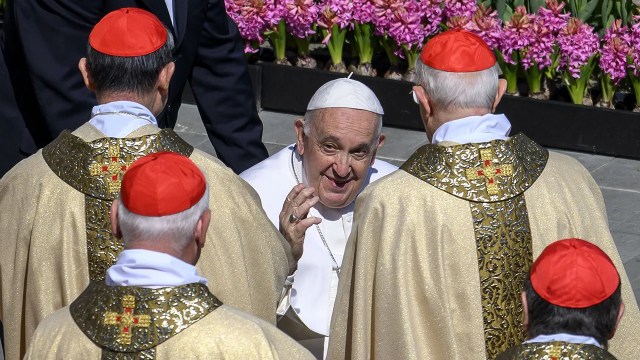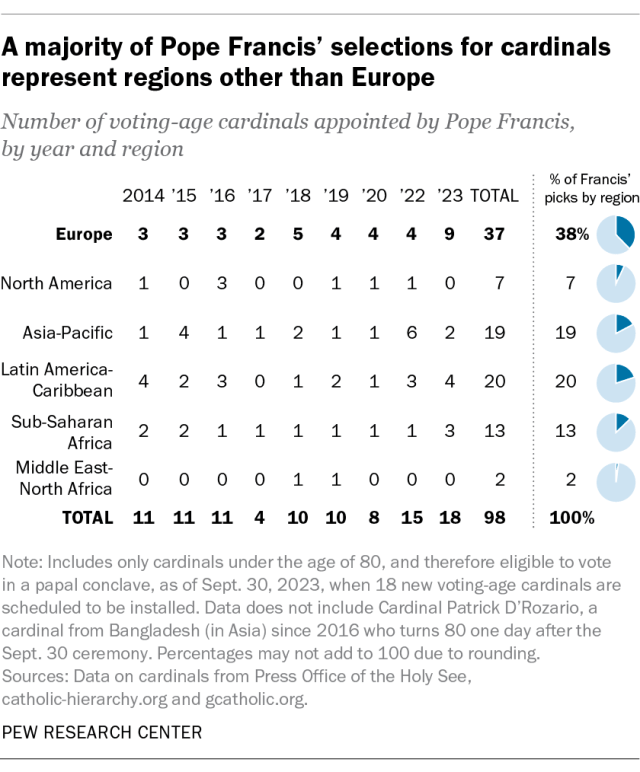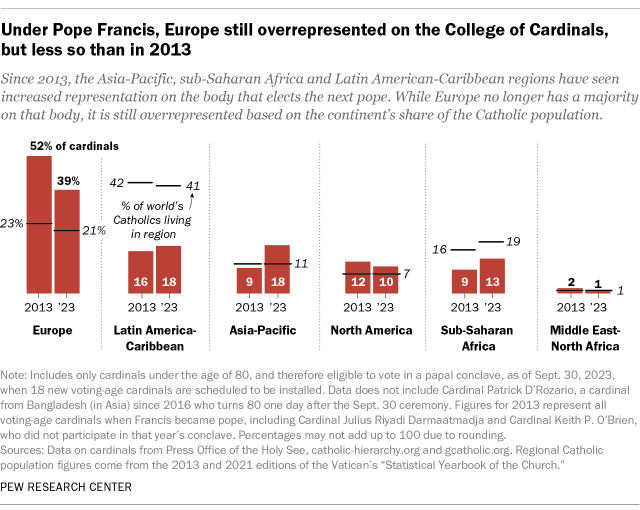
Unless his reign is short, a pope usually appoints a majority of the men who will vote for his successor after he dies (or resigns). But Pope Francis’ picks for the College of Cardinals since his election in 2013 have also served another purpose. Over time, they have tilted the leadership structure of the Roman Catholic Church away from its historic European base and toward countries in Africa, Asia and Latin America.
This analysis looks at the regional distribution of Pope Francis’ selections for new cardinals (since 2014, the year after he became pope). It looks only at cardinals who are under 80 years old and therefore eligible to vote in a papal election. The data in this analysis comes from the Vatican website and from other websites that maintain databases of cardinals, including gcatholic.org and catholic-hierarchy.org. Given that Cardinal Patrick D’Rozario of Bangladesh turns 80 on Oct. 1, 2023, the day after the newest cardinals are scheduled to be installed at a Vatican ceremony, he is not included in the count.
For the analysis, each cardinal is assigned a single geographic region from among the following: Asia-Pacific, Europe, Latin America-Caribbean, Middle East-North Africa, North America and sub-Saharan Africa. Most often this is the same as their region of birth, but there are some exceptions. Cardinals who lead a diocese or an archdiocese are counted as being associated with the region of the world where that diocese or archdiocese is located, even if they were born in a different region. For example, Giorgio Marengo was born in Italy but has served as apostolic prefect of Ulaanbaatar, Mongolia, and is counted as representing the Asia-Pacific region.
Cardinals who hold or have held Vatican positions are counted as being from the region of the world where they spent most of their years in the clergy prior to working at the Vatican.
The analysis also uses data on national breakdowns of the worldwide Catholic population compiled by the Vatican in the 2013 and 2021 editions of its annual yearbook, “Annuarium Statisticum Ecclesaie,” or “Statistical Yearbook of the Church.” Vatican figures are based on the number of baptized Catholics in each country. (Previous versions of this post used 2010 survey data from Pew Research Center’s demographic study titled “The Global Catholic Population.”)
In late September, 18 new voting cardinals will be installed at a ceremony in Vatican City. At that point, there will be 136 cardinals who are under 80 years old and thus eligible to vote in the next papal election. Here’s how the regional breakdown of all the voting cardinals will look after the next installment ceremony, compared with when Francis became pope a decade ago:
- The Asia-Pacific region will account for 18% of voting-age cardinals, up from 9% in 2013.
- The Latin American-Caribbean region will have 18%, up from 16% in 2013.
- Sub-Saharan Africa will account for 13% of cardinals, up from 9% in 2013.
- Europe will have 39%, down from 52% in 2013.
- North America will account for 10%, down from 12% in 2013.
- The Middle East-North Africa region will have 1%, down from 2% in 2013.
The figure of 136 voting cardinals excludes Patrick D’Rozario, a cardinal since 2016 whose 80th birthday is one day after the Sept. 30 ceremony.
A look at Francis’ picks over time
Francis, an Argentine who is the first pope from outside Europe since the eighth century, still has picked more cardinals from Europe than from any other region.

Of the 98 voting-age cardinals Francis has named during his papacy (including the 18 cardinals-elect), 38% are from Europe, 20% are from Latin America and the Caribbean, 19% are from the Asia-Pacific region, 13% are from sub-Saharan Africa, 7% are from North America and 2% are from the Middle East-North Africa region.
Altogether, the cardinals appointed by Francis will make up 72% of the 136 voting members of the College of Cardinals after the Sept. 30 ceremony. The remainder were appointed by Pope Benedict XVI and St. John Paul II.
Looking just at the new 18 voting-age cardinals who will be installed Sept. 30, here is the geographical breakdown:
- Nine will represent European countries, including France (2 cardinals-elect), Italy (2), Spain (2), Poland (1), Portugal (1) and Switzerland (1).
- Four will represent Latin America and Caribbean countries, including Argentina (2), Colombia (1) and Peru (1).
- Three will represent countries in sub-Saharan Africa: South Africa, South Sudan and Tanzania.
- Two will represent Asia-Pacific countries: China and Malaysia.
Cardinals and the world Catholic population
Vatican data from 2021 shows that 21% of the global Catholic population lives in Europe, so the continent remains heavily overrepresented among voting cardinals (39% of whom are from Europe). By this measure, the most underrepresented region within the church’s leadership – even with Francis’ new picks – is the Latin America-Caribbean region, which was home to 41% of the worldwide Catholic population as of 2021 but has only 18% of the voting cardinals.

Note: This is an update of a post originally published Nov. 17, 2016, and most recently updated on July 19, 2022.
